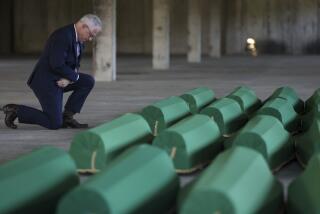Genocide Trial of Bosnian Serb Is to Start Today
- Share via
THE HAGUE — From aerial spy photos, from cadavers dug out of mass graves with blindfolds still on their faces and rope binding their hands, the silent victims have been crying for justice for almost five years.
And today, a 51-year-old professional soldier who lost his right foot to a land mine is to go on trial for the most concentrated act of bloodletting in Europe in more than half a century. Maj. Gen. Radislav Krstic, former chief of staff and commander of the Bosnian Serb army’s Drina Corps, is charged with genocide, war crimes and crimes against humanity in the organized butchery of at least 7,000 men and boys in the Bosnian Muslim enclave of Srebrenica.
The trial is the most important yet at the International Criminal Tribunal for the Former Yugoslavia, created by the United Nations to prosecute those responsible for mass murder, brutal “ethnic cleansing” of civilians and other crimes against international law during Bosnia-Herzegovina’s 3 1/2-year civil war. And, unless wartime leaders Radovan Karadzic and Gen. Ratko Mladic are captured, Krstic will be the highest-ranking Bosnian Serb official called to account.
The case is the best opportunity yet that prosecutors at The Hague tribunal have to obtain something that has eluded them so far: a conviction for genocide, buttressing their charge that the Bosnian Serb leadership sought to destroy all, or part of, the Balkan nation’s Muslim community.
“Krstic is the senior-most Bosnian Serb military figure to come before the tribunal,” prosecution spokesman Paul Risley said. “More important, the crimes for which he is charged are the most serious crimes to come before the tribunal so far.
“The killing of Bosnian males in July 1995 was certainly the most violent episode in the history of Europe since World War II,” Risley said. “It was a crime the entire world was aware of, and watched.”
On July 11, 1995, the 15,000 soldiers of the Drina Corps overran the U.N.-declared “safe area” of Srebrenica in eastern Bosnia, which was packed with Muslim refugees. Women and children were expelled by the tens of thousands. Over a five-day period, Muslim men and boys were slaughtered after surrendering, or hunted down and killed as they attempted a desperate 40-mile march to Tuzla, another Muslim town.
Once in the hands of Bosnian Serb soldiers, the males were massed together in such mundane locations as a gymnasium, a warehouse and a soccer stadium and were killed efficiently and methodically by machine-gun fire or hand grenades.
“This is not a case, like others, where you have thugs, soldiers or paramilitaries who got out of hand and did something unlawful,” said Heather Ryan, a Boulder, Colo., attorney serving as liaison in The Hague for the Coalition for International Justice, a nonprofit organization that assists the war crimes tribunal. “Here, there was a very deliberate, blatant, organized decision by the military to execute people.”
According to the charges against him, Krstic was in command of the mass slayings, or at the very least did not use his authority to stop them. Among the victims of the killing frenzy were 1,000 old men, as well as prisoners who had surrendered to Bosnian Serb troops. Boys as young as 12 also were cut down in cold blood.
Krstic, whose indictment had been kept a secret, was arrested by U.S. troops in Bosnia in a road ambush Dec. 2, 1998, and sent to The Hague. He has pleaded not guilty to the charges and is being held in a detention cell here on the North Sea coast.
At his arraignment a week after his arrest, the former officer in the Yugoslav federal army was allowed to remain seated because of his maimed leg, which he injured by stepping on a mine early in the Bosnian conflict.
The butchery in Srebrenica and other towns that the U.N. Security Council had declared “safe areas” but that member states, including the United States, refused to authorize adequate troops to protect, marked a turning point in the war. Four months later, U.S. pressure produced the Dayton, Ohio, peace accords and a heavily armed peace force for Bosnia led by the North Atlantic Treaty Organization.
“The tragedy of Srebrenica will haunt our history forever,” U.N. Secretary-General Kofi Annan said last November in a self-critical report examining the fiasco of U.N. operations there. When Bosnian Serb soldiers attacked, there were only 110 lightly armed Dutch peacekeepers in the town.
To fix responsibility for the massacres in and around Srebrenica, prosecutors in The Hague have had access to photographs of mass graves taken by U.S. spy satellites--the first time such sensitive intelligence material has been given to the tribunal.
In addition, forensic investigators have been searching for and digging up mass graves, some miles from Srebrenica, for the last four years. According to prosecutors, the Bosnian Serb forces made a concerted attempt to conceal their misdeeds, digging dozens of new trenches and moving corpses from old graves in a grisly game of hide and seek with international investigators.
At last report, only about 2,000 bodies had been recovered, although the International Committee of the Red Cross has put the number of missing at Srebrenica at more than 7,000 and tribunal prosecutors cite a figure of 8,000.
According to sources here, photographs of the dead will be presented at Krstic’s trial, in some cases showing victims blindfolded and with their hands tied behind their backs. Sometimes, the very bullet that killed a man or boy has been recovered along with his remains.
At least 50 witnesses will be called by the prosecution, which is headed by Mark Harmon, an American who served for 12 years as the Santa Clara, Calif., public defender. The prosecution case, expected to last for four straight weeks, will also attempt to establish the chain of command that led from Krstic to Mladic, overall head of the wartime Bosnian Serb military, and Karadzic, then the Bosnian Serb president.
“When Karadzic and Mladic find themselves in The Hague, the crimes they are called to account for will be based in large part on Srebrenica,” Risley said. Both men, still at large, have been under indictment on charges of genocide since 1995.
Until now, only Drazen Erdemovic, an ethnic Croat enrolled by force in a Bosnian Serb execution squad, has stood trial for the Srebrenica killings. Currently serving a five-year prison term in Norway as a result of his conviction, he is likely to be called as a prosecution witness against Krstic.
Next Monday, the war crimes tribunal is to begin another high-profile trial, that of a group of Bosnian Serb soldiers accused of sequestering Bosnian Muslim women and repeatedly raping them. According to legal experts, the trial will be the first at which rape is prosecuted as a crime against humanity.
More to Read
Sign up for Essential California
The most important California stories and recommendations in your inbox every morning.
You may occasionally receive promotional content from the Los Angeles Times.













